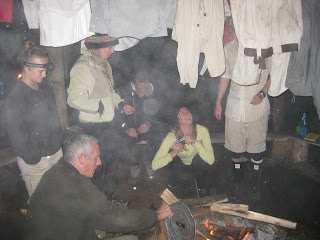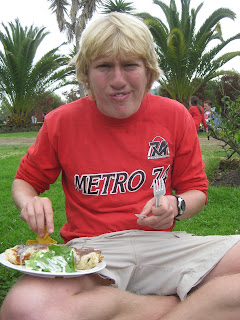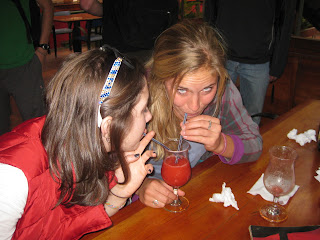Hey everyone,
Sorry it’s been a little while—I’ve been roughing it for the last
few days. It’s been an exciting few days, in good ways and bad.
On Thursday, my Spanish class (all 6 of us, Professor Tómas
included) went to El Museo de Ciencias
Naturales (Natural Science Museum) and a vivarium. The trip there was pretty exciting for the
following reason: an Ecuadorian woman tried to rob me on the bus. I had a
really bad feeling about her as soon as she got on the bus, so I turned my
purse away from her. However, as I was getting off the bus, I felt her push up
against me, and I felt her hand looking for my front pocket. I thought nothing
of it, however, because I knew I had nothing in my pockets. However, when I got off the bus, I turned to
tell my friends that she had just tried to rob me. I looked down and saw that
the side of my bag was sliced open. My digital camera, my iPod shuffle, and my
wallet were all accounted for, and I came to the conclusion that she didn’t
escape with anything. I was obviously pretty mad though, and I couldn’t believe
I didn’t trust my instincts enough to turn around and say something to her. But
alas, I’ve learned my lesson.
The museum and vivarium were super cool though! The science museum
was typical of what you’d imagine in the States, but a bit more low-tech. I
loved learning about science in Spanish! After the first museum, we walked to
the vivarium, where snakes, frogs, toads, and other various reptiles and
amphibians are housed. We learned about
lots of different snakes, both poisonous and non-poisonous. At the end of the tour, we were collected
into a room with a bunch of little kids, and the guide spent the following 5
minutes trying to convince us that snakes weren’t all dangerous. I needed no
convincing and gladly participated in touching the boa constrictor that the
woman had wrapped around her. Awesome
field trip.
 |
| A few of my classmates and I at the Museum of Natural Sciences: Lizzie, Me, Laura, Amanda, and Sam |
We left early on Friday morning for our Conservation Biology/Terrestrial
Ecology class fieldtrip to El Pahuma Orchid Reserve an hour northwest of Quito
in the Andean cloud forest. On the way to El Pahuma, we stopped at La Mitad del Mundo, or the center of the
earth (one of the infinite number of points on the equator at 0° latitude). We
also stopped at a gas station, where I met some Ecuadorian high schoolers and
their chaperones and chatted with them a bit. One of the boys convinced me to
try an authentic Ecuadorian baked good. So, for a dollar, I picked up a bag of
10 delicious strawberry pastries. No regrets there.
 |
| At the center of the Earth |
 |
| The monument at the center of the Earth--fun fact: it's actually a few hundred meters off. |
Anyway, a bit of background
on our destination:
Ceiba Foundation for Tropical Conservation (the foundation I’m
studying through) took El Pahuma on as a project about 15 years ago. The land is owned by a local family, the
Limas, but is under an easement, or a type of legal contract, with the Ceiba
Foundation. Fifteen years ago, Joe and Cath, my professors and the founders of
Ceiba, made an agreement with the Limas. If the family conserved the land and
didn’t use it for wood or pastures, Ceiba would help them maintain it, and
hopefully turn it into a small spot for tourists and/or students to learn about
cloud forests and conservation. To this
day, the land has been maintained and conserved, and a couple buildings have
been built to host visitors (from school children to university students to
foreigners).
Since our professors started the project, our group reaped the benefits
of their relationship. Upon arrival, we were fed an authentic Ecuadorian lunch
of soup, fried trout, choclo (a type
of corn-on-the-cob), rice, salad, and (maybe not so authentic) Tang orange
drink. We did a few activities in the
botanical garden after lunch, and learned about a few plant families. Around
mid-afternoon, we were split into two groups—the first group would be hiking up
the mountain and staying in a cabin on the first day, and the two groups would
switch on the afternoon of the second day. I had been feeling the onset of a
cold on Friday morning, so by afternoon I was feeling a bit under the weather.
Just a minor detail to add to the ones to follow.
I was in the group that stayed at the bottom of the mountain the
first night. Before dinner, our group,
led by Joe, hiked up the mountain about a half hour to la cascada grande (or the bigger of the two waterfalls). It had
rained a lot in the days previous, so the waterfall was gushing. A couple of my
classmates lined up for a picture and a rock flew out of the waterfall and hit
my friend Molly in the back of the head. It was the start to a
semi-dramatic weekend, to say the least. We learned some
more about plant families, and returned to the cabin for dinner.
 |
| My weekend classroom. |
 |
| My paraguas del pobre, or poor man's umbrella. |
 |
| Waterfall! |
After dinner, we had some time to rest a bit. Joe brought a
guitar, so my classmate Jake and I chilled and passed the guitar back and
forth. As soon as it was dark, we went
on a night hike to see if we could find some cool wildlife. It was so cool to experience the cloud forest
at night. As you can guess from its name, it’s nearly always foggy/cloudy in
this part of the mountains. Walking
through the jungle with our headlamps illuminating the 10 yards in front of us
was pretty magical. We saw a few frogs,
but other than that it was a pretty uneventful night hike.
The next morning, we got up to eat breakfast around 7:00. The
family fed us fresh fruit, eggs, toast and marmalade, and coffee. We had a little bit of time to rest, and then
we had lecture at 9:00. Our lecture was on the porch of our humble cabin,
overlooking the botanical garden. If you have to have class, it doesn’t get
much better than that. We then did an
activity with pressing plants, and my friend April and I collected a nice
flower to identify and press. After pressing
our beautiful orange Gesneriaceae (a
plant family), we went to have lunch. This meal was my favorite of the whole
weekend. We had choclo, avocado,
fried pork, a sliced carrot/onion salad, tostados
(toasted corn kernels—analogous to CornNuts if they were healthier), and more mellocos (those potato-like things from
my last post). Suffice it to say we were more than fueled up for our afternoon
hike up the mountain.
 |
| Our porch-style lecture hall. |
 |
| Almuerzo--lunch! |
 |
| Shot of the cloud forest. |
The hike up the mountain was moderately strenuous. For an hour and
a half (the locals can do it in 25 minutes), I trudged straight up the mountain
in the rain on a semi-established path. Between asthma and altitude, I
definitely had to stop for air a few times. However, since our professors had
made it seem like a monster, I reached the “top” (it was actually only about
half-way up) before I expected. Waiting for us was a small cabin and a shelter
with a campfire underneath. There was obviously no running water (aside from
the rain running down the mountain) or electricity. Two members of the Lima
family were up there waiting for us (having just hosted the other 10 members of
my class the night before) with hot tea and popcorn. With the help of some
other family members, they had carried over a dozen plastic tubs of purified
water, all of the cooking utensils, and all of our food up there. Talk about
impressive. We had mini-lecture about
birds while we huddled around the campfire. We then had dinner of spaghetti and
sauce with salad, and hot chocolate. I hate to say it, but even despite the
fabulous Ecuadorian food, I really have missed my pasta. It was quite the treat! The hot chocolate was
also some of the best (and most natural) I’ve tasted, and definitely wasn’t
Swiss Miss. We also went for a night
hike on Saturday night, but it was extremely muddy and rainy, and we didn’t
find much.
 |
| A crummy picture of our campfire shelter |
 |
| My classmates, pretending to be on a roller coaster, with Adam in the back, Jake, Laura, and Lizzie in the middle, and April in front. |
 |
| Enjoying s'mores around the campfire--the graham crackers are sweeter here. :) |
Sunday morning I woke up super early because I was feeling
extremely sick. This was the start to
what was to become my most dehydrated 48 hours ever. At some point in the week or so before the
trip, I must have eaten something (maybe the watermelon off the street?) with a
parasite in it, and I (with the help of trusty Joe) decided I had amoebic dysentery. Word to the wise: if you’re planning on
contracting a parasite, don’t learn about them before you do it. Few thanks to
Professor Bruce Christiansen, I was well-informed about the protists that had
taken up residence in my gut.
I wasn’t going to miss out on the hike up the rest of the
mountain, though. After breakfast, which
I had neglected eating, our class hiked to the top of the mountain to the Yumbo
trail. There is a bird called the Yumbo
that calls back and forth across mountain peaks. A long time ago, people used
to do the same between the Andean peaks that we were visiting. The Yumbo trail
was named for these people that called back and forth like the birds. Before
the arrival of the Spaniards, the trail was worn down deep into the mud by the
thousands of natives that carried heavy packs from the coast to the mountains
for trading. The trail has since been used for smuggling, commerce, and evasion
of the Spaniards. It was really cool to
walk the same trail. After a quick
packed lunch at the top of the mountain, it began pouring rain. It must have been quite a sight to see us
literally slipping and sliding down the mountain back to our cabin. After packing up all of our things, we hiked
another hour or so back to base camp at the bottom of the mountain and got
ready to leave. While we were waiting
for everyone to pack up, we changed out of our sopping, muddy clothes, into dry
ones, and sat on the porch playing guitar. As my friend Amanda joked, between
the rain dripping off the porch roof, our beautiful surroundings, and the sound
of a guitar, it was a pretty perfect setting if you were going to do any deep
thinking.
 |
| Stopping to do some learning on the way to the top. |
 |
| A view of the canopy from the forest floor. |
 |
| April and I posing in front of what I like to call the "bunny ear" plant. |
 |
| The worn down Yumbo trail. |
After loading the bus, we had a quick snack and left. At this
point, I was more than ready to be home.
I felt awful and I was wet and cold. I know it sounds wimpy, but I was
definitely looking forward to my first shower in 3 days. When I finally made it home, my warm shower
wasn’t working (I later learned that the hot water heater had run out of gas).
So I instead proceeded to tend to my dysentery, if you catch my drift. I went to bed around 6:00 a.m., not before
making sure I had thrown up the last of whatever might have been in my stomach. Sorry for the overload of information, but
these things are parts of my experience. :)
I woke up around 10:00 (Joe and Cath had given us the morning off,
thank goodness), ate breakfast, threw it up, showered (hot water heater
fixed!), did my Spanish homework, and went to Spanish class. At that point, my stomach was feeling a
little better, but I was starting to really feel my state of dehydration. I
drank a bottle of water and a bottle of Gatorade (for those of you who know me
well, this is lots of liquid for me), and by 5:00 I felt much better. As of now, I don’t think I’ll be needing the
Flagyl that Joe told me he’d give me if I needed it to get rid of my amoeba
friends.
I thought that was the end of my medical ailments for the time
being, but I was mistaken. Since I had
returned home from the forest, my foot that was injured last Tuesday or Wednesday
playing soccer had become infected. If
it were up to me, I would have ignored it, more or less. But as I currently
live under the care of an overprotective, loving Ecuadorian family, my host
mother was horrified to see the infection that had developed. She sat me down, and for an hour proceeded to
scrub at my open sore with cotton and agua
de manzanilla (an antibiotic tea), swearing that the scab that had developed
was actually puss. As painful as it was, I didn’t have the heart to tell her
that I would probably survive if she left it alone. When the ”puss” wouldn’t come off, she
insisted on taking me to la clínica,
a clinic about 20 yards from my house where her daughter María José is a
receptionist. We saw a nurse who clucked at my cut, scrubbed ferociously at my
foot for 30 seconds, put a larger-than-necessary bandage on it, and sent me on
my way. Cecilia seemed satisfied with this, and only needed to put antibiotic
cream on it when we got home.
 |
| My foot wound, pre-infection. |
Needless to say, it’s been an overly dramatic week here. But, as
usual, I just take everything in good stride, and chalk it up to “the
experience.” If every weekend trip is as beautiful as last weekend’s, I think I’ll
be in good shape.
Here are a few things I learned:
-Some species from the family of plants called the Gesneriaceae are also jokingly called
the “gay plants.” This is because the
male reproductive parts of the plants (called stamens) are fused together, held
away from the female parts of the plant. Very clever, botanists of the past,
very clever.
-The birds of the tropics are much prettier than birds of the
temperate zone (e.g., the Midwest). I saw a blue mountain tanager up at the top
of the mountain, and with my new binoculars (thanks Mom and Dad!) he was
gorgeous.
-I love nature. I already kind of knew that one, but being out in
the thick of it last weekend was fantastic.
-The manuscript of the book that is now The Power of One was
originally used as a doorstop because the author, Bryce Courtenay thought it
was no good. I’m in the middle of listening to the audiobook now, and it makes
for a great commute.
Just one shoutout today, to Ms. Ann Kroncke. I have a lot of doubts
that she is actually reading this, but I support her theories that nature is
great and that it’s fun to learn about plants and animals. I suppose I already
knew that, but in any case, Ms. Kroncke, you’d be thrilled by the tropics.
¡Hasta luego amigos!




































